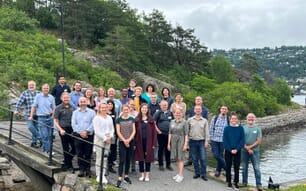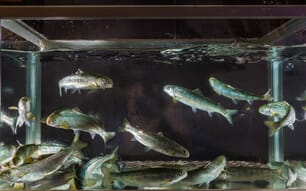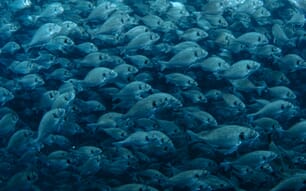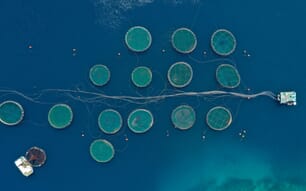
Post-doc researcher Xinxin Wang with a crop of sugar kelp in northern Norway © Philip James, Nofima.
As kelp aquaculture is a relatively new industry in Norway, and in many parts of Europe, there are many challenges to overcome before production can increase and become commercially viable. Active cultivation sites in Norway are scarce and concentrated towards the southern and mid-coastal regions; however, kelp farming also shows great potential in northern Norway. Therefore, researchers at Nofima are currently focusing on sustainable value creation from kelp production in northern Norway.
The world’s largest aquaculture crop
Despite seaweed being a relatively new aquaculture species in Europe it is – in terms of harvested volumes – the largest aquaculture sector in the world. There are three types of seaweed: brown, red and green. Although there are a vast range of species (with approximately 10,500 described) the production of seaweed is concentrated on nine genera, including well-known species such as Japanese kelp, nori and wakame.
Seaweed represent more than half of the total worldwide production of marine aquaculture by volume and 99 percent of this production is concentrated in Asian countries. Recently, seaweed farming has expanded to European countries, with Saccharina latissima (sukker tare in Norwegian, or sugar kelp in English) being the most important and commonly cultivated commercial species. Kelp species are excellent candidates for aquaculture as they are among the fastest-growing organisms on this planet (growing up to several centimeters per day) and are capable of reaching more than 2m in length during a single growth season. They are attached to growing ropes by holdfasts, which only have an anchoring function and – unlike the roots of terrestrial plants – these are not requited for the absorption of nutrients. From the holdfast elongate stem-like structures called stipes, and then blades, develop.
Applications and benefits of seaweed
Most farmed seaweed biomass is consumed as food, as they are rich in minerals and vitamins, with some species also containing high amounts of proteins and fatty acids. Extracts from seaweed can be used in a wide range of product applications – such as animal feed, toothpaste, cosmetics and medicines – that contain hydrocolloids for gelling or thickening purpose. And more promising and innovative applications are coming, including textile and plastic alternatives for packaging, and coatings for food containers and drinking straws. However, there are concerns about the health effect of high iodine intake from seaweed. The variation of iodine concentration is large between and within species. Brown seaweeds contain a high level of iodine while green and red seaweeds, including the popular sushi seaweed nori, are relatively low in iodine. Moreover, the iodine content can be reduced through processes including drying, boiling and frying.
Seaweed also provides several key ecosystem services and could help to solve several of today’s most pressing environmental and social sustainability challenges. In integrated multi-trophic aquaculture (IMTA) systems, kelp can be integrated with fed species, such as salmon, and non-fed species, such as oysters, mussels, scallops to reduce the nutrient loads, improve the water quality, increase the biodiversity, at the same time enhancing the overall productivity of the system.
As a primary producer, kelp absorbs CO2 and converts carbon into biomass. Large-scale cultivation of kelp provides a promising means to reverse ocean acidification and to help reduce the impact of the current climate crisis. This also closely aligns with existing efforts to restore ocean health and create a sustainable ocean economy.
Different production systems
To cultivate kelp efficiently, understanding the physical and biological factors that affect survival and growth – as well as developing appropriate production strategies – are among the keys to success. The main environmental variables for the growth of kelp are the availability of nutrients, light, temperature and currents. Kelp can be grown in fjords, as well as the near-shore and offshore environments. In addition, it can be integrated into existing mariculture installations, or windfarms.
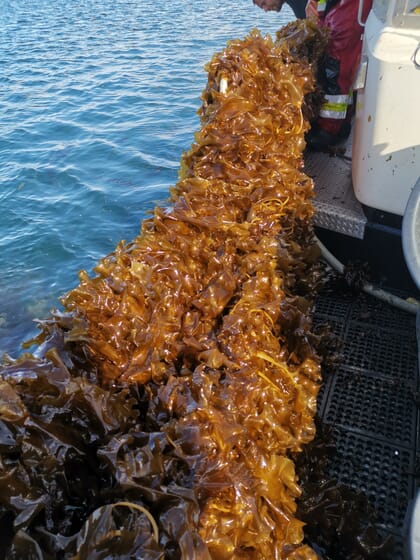
© Xinxin Wang, Nofima.
Northern Norway is perfectly suited to kelp farming
Kelp farming faces a number of challenges but also advantages in areas that are not currently used to produce seaweed. Active cultivation sites in Norway are scarce, even though kelp farming shows great potential in northern Norway. Photosynthesis is key in the cultivation of kelp, and in the north there is sunlight around the clock during the summer season, meaning that growth rates are amazing in this period, with huge potential to develop a kelp industry.
Sugar kelps are cold-water species and seawater temperature below 10°C are suggested to be the optimal temperature for their growth and the key factor foe delayed outbreak of epiphytic (fouling) organisms. This is one of the main challenges to viable seaweed cultivation, as once the plants become overgrown with fouling organisms they rapidly lose their value. The seawater temperature in one of Nofima’s experimental sites in the north never exceeded 10 °C during the growth period (February to August), which is a perfect location for kelp cultivation.
Kelp cultivation produces large volumes of biomass that must be harvested and processed during a very short and intensive period (dictated by the onset of biofouling). The growth season in southern Norway ends in May, when water temperatures increase, and the epiphytic organisms start to occur on cultivated kelp, making them unsuitable for human consumption.
Our preliminary results showed that the outbreak of epiphytic organisms was considerably later in northern Norway, which allowed for a prolonged growing season and later harvesting in July/August. Despite the lower temperatures the biomass yield in the north is comparable to that experienced in the southern and mid-coastal regions of Norway. Results from Nofima trials revealed large variations in the kelp growth and quality, even within the northern region.
A site with lower temperature and normal salinity experienced better kelp growth than another site close by, regardless of the origin of the mother plants. This shows that in addition to geographic location, the local environmental conditions will be key to locating seaweed farms in the north of Norway.
Further consideration
Seaweed cultivation requires specific solutions regarding the temporal, spatial and practical integration of production techniques and these solutions are specific to each production site. Therefore, the existing cultivation methods applied in southern and central Norway may not be entirely suitable for northern Norway. Abiotic conditions vary significantly with latitude and play a major role in genetic adaptation, growth and quality potential. Thus, for an efficient and sustainable increase in kelp aquaculture production in northern Norway, it will be essential to assess existing cultivation methods and genomic variation on local scales for application to the local industry.
Moreover, little research has been done on the genetic distribution of various seaweed species, including kelp, and the potential to utilise selective breeding to improve the value of this or other species has not been explored. Currently, the industry is also almost exclusively based in the south and middle parts of Norway. This ignores the enormous potential to grow and expand the fledgling industry in Norway by producing seaweed in the north. Finally, the markets for seaweed-based food and food additives needs to continue to expand. This can likely be driven by our changing perceptions towards a healthier and more sustainable diet and growing appreciation of the health benefits associated with seaweed-based products.

